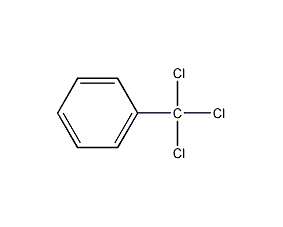(Trichloromethyl)benzene

Structural formula
| Business number | 02D8 |
|---|---|
| Molecular formula | C6H5CCl3 |
| Molecular weight | 195.47 |
| label |
benzene chloroform, Benzchuan trichloride, Trichlorobenzyl, Benzene chloroform, α,α,α-trichlorotoluene, (Trichloromethyl)-benzen, Ai3-02583, Alpha,alpha,alpha-trichloromethylbenzene, Alpha,alpha,alpha-trichloro-toluen, Benzene,(trichloromethyl)-, Benzenyl chloride, Aromatic halogen derivatives |
Numbering system
CAS number:98-07-7
MDL number:MFCD00000786
EINECS number:202-634-5
RTECS number:XT9275000
BRN number:508152
PubChem number:24862796
Physical property data
1. Properties: colorless to light yellow transparent liquid with special odor.
2. Density (g/mL, 25℃): 1.380
3. Relative vapor density (g/mL, air=1): 6.77
4. Melting point (ºC): 4.8
5. Boiling point (ºC, normal pressure): 220.6
6. Relative density (20℃, 4℃): 1.23728
7. Refractive index: 1.557
8. Flash point (ºC): 97
9. Liquid phase standard hot melt (J·mol-1
sup>·K-1): 213.5
10. Autoignition point or ignition temperature (ºC): 211
11. Vapor pressure (mmHg, 20ºC): 0.2
12. Saturated vapor pressure (kPa, 40ºC): 0.133
13. Heat of combustion (KJ/mol): 5866.5
14 . Critical temperature (ºC): Undetermined
15. Critical pressure (KPa): Undetermined
16. Log value of oil-water (octanol/water) partition coefficient: Undetermined
17. Explosion upper limit (%, V/V): 5.6
18. Explosion lower limit (%, V/V): 2.1
19. Dissolution Properties: Insoluble in water, soluble in ethanol, benzene, ether, etc.
Toxicological data
1. Irritation: Rabbit transdermal: open irritation test, 10mg/24 hours, severe irritation. Rabbit transdermal: 20mg/24 hours, moderate irritation. Rabbit eye: open stimulation test, 50μg, severe stimulation. Rabbit eye: 50μg/24 hours, severe irritation.
2. Acute toxicity: LD50: 6000 mg/kg (rat oral) LC50: 19 ppm (rat inhalation)
Ecological data
This substance may be harmful to the environment. It is recommended not to let it enter the environment.
Molecular structure data
1. Molar refractive index: 45.28
2. Molar volume (cm3/mol): 140.7
3. Isotonic specific volume (90.2K ): 351.2
4. Surface tension (dyne/cm): 38.7
5. Dielectric constant:
6. Dipole moment (10-24cm3):
7. Polarizability: 17.95
Compute chemical data
1. Hydrophobic parameter calculation reference value (XlogP): 3.7
2. Number of hydrogen bond donors: 0
3. Number of hydrogen bond acceptors: 0
4. Number of rotatable chemical bonds: 0
5. Number of tautomers:
6. Topological molecular polar surface area (TPSA): 0
7. Number of heavy atoms: 10
8. Surface charge: 0
9. Complexity: 99.9
10. Number of isotope atoms: 0
11. Determine the number of atomic stereocenters: 0
12. Uncertain number of atomic stereocenters: 0
13. Determine the number of chemical bond stereocenters Number: 0
14. Number of uncertain chemical bond stereocenters: 0
15. Number of covalent bond units: 1
Properties and stability
1. Avoid contact with humid air and contact with oxidants.
2.This product is toxic, with an oral LD of 506g/kg in rats. Operators wear protective equipment. The production workshop should have good ventilation and the equipment should be sealed.
Storage method
1. Store in a cool, ventilated warehouse. Keep away from fire and heat sources. Protect from direct sunlight. Keep container tightly sealed. should be kept away from oxidizer, do not store together. Equipped with the appropriate variety and quantity of fire equipment. The storage area should be equipped with emergency release equipment and suitable containment materials. 2. Lined with plastic bags and packed in iron drums. There should be a clear “Drug Contains” message on the packaging. It is organic and contains drugs. Danger regulation number 84139. It should be stored in a cool, dry and ventilated warehouse, away from fire and heat sources, and away from direct sunlight. It should not be stacked with flammable materials and edible chemical raw materials. When transporting, load and unload gently to prevent damage to the packaging.
Synthesis method
Prepared from the chlorination of toluene. Add catalyst phosphorus trichloride to toluene, heat to boiling, pass chlorine for 15-20 hours under good light, stop passing chlorine when the boiling point of the liquid reaches 215°C. Distill under reduced pressure and collect the fraction at 97-98°C (1.6kPa), which is the finished product with a yield of 90%.
![]()
Purpose
Used as raw material for dyes and other organic synthesis.
